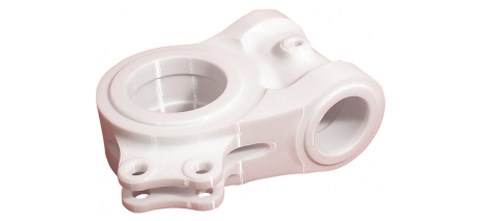In addition to its biocompatibility, manufacturing parts with PC-ISO provides the following benefits:
Superior strength: PC-ISO is one of the strongest FDM thermoplastics and has a 63 percent higher tensile strength and 67 percent higher flexural strength than ABS-M30i, the other biocompatible FDM thermoplastic. The added strength gives parts the durability to endure demanding applications, such as tools for medical and food packaging.
Advanced sterilization: The heat deflection temperature of PC-ISO is 271 degrees Fahrenheit.[1] This resistance is important when sterilizing medical devices and surgical tools with high temperatures to kill bacteria. PC-ISO parts can be sterilized with two of the more common methods: gamma and Ethylene oxide (EtO).
Translucence: PC-ISO is available in two colors: white and translucent. With natural translucent, you can monitor the flow of liquid or solids through the part. The translucent material is also commonly used for prototyping lighting fixtures.
Often PC-ISO parts for medical applications require a level of secondary operations, in which you should consider the following:
Choose the best finishing options: FDM parts can be sanded, vapor smoothed, machined, primed or painted to meet virtually any aesthetic requirements, whether it is a specific smoothness or sheen. Because of the inherent toughness of PC-ISO, some techniques do not work for these parts. Vapor smoothing is not effective for PC-ISO because the chemicals used in the process are not able to penetrate the surface of the part. Instead, bead blasting can provide a matte or satin finish. Consult with a Stratasys Direct Manufacturing engineer to determine the best secondary operations based on your project’s specifications.
Note the breakaway support material: In the build process, FDM uses a support material that acts as scaffolding for components of the part that can’t be built over air. While the ABS-based thermoplastics rely on water-soluble support material, PC-ISO supports are broken away and removed by hand. Breaking away these supports can risk damage to intricate features of a part. A Stratasys Direct Manufacturing engineer will help choose a build orientation to minimize the need for supports.

